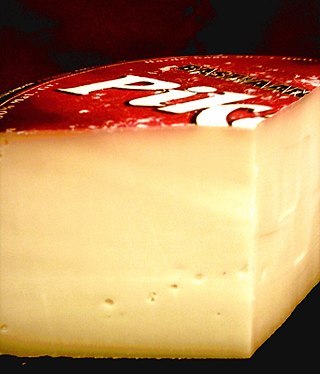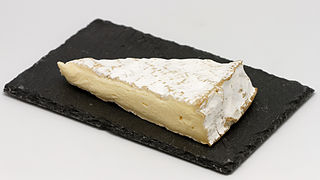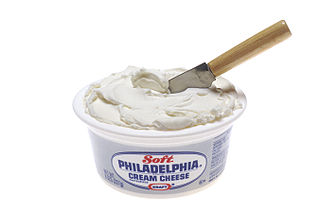See also
- Dutch cheese markets
- Edam cheese – Semi-hard Dutch cheese
- Gouda cheese – Dutch yellow cheese made from cow's milk
- List of cheeses – List of cheeses by place of origin
| Maaslander | |
|---|---|
| Country of origin | Netherlands |
| Region | Huizen |
| Source of milk | Cows |
| Pasteurised | Yes |
| Texture | Semi-hard |
| Fat content | 30-48% |
| Aging time | Up to 10 months |
| Certification | No |
Maaslander is a brand name for a Gouda, semihard cheese from the family Westland aka Westland Cheese Specialties BV, located at Huizen, the Netherlands. Maaslander is one of the first Dutch cheese brands, and it is a protected designation of origin. Including the green and yellow stripes, and also the name lander.
Regular Dutch Gouda cheese contains salt from the use of brine in the production, which can lead to a high bloodpressure. So, the company began producing the Maaslander at a factory in Arkel in 1978. This cheese, slightly shallower, with a shorter time of immersion, resulted in a lower salinity and a mild-flavored cheese. Due to the shorter curing, the cheese contains more milk fluid.
Cheese factories outside the Netherlands also produce Maaslander cheese, for example in Flensburg, Germany.
Westland specializes in the sale of branded cheese. Old Amsterdam is also a brand of the company. In the UK Old Amsterdam is marketed by Bradbury's of Buxton, a company founded, in 1884, as Bradbury and Son, by Reverend William John Bradbury. [1]

Cheddar cheese is a natural cheese that is relatively hard, off-white, and sometimes sharp-tasting. It originates from the English village of Cheddar in Somerset, South West England.

Gouda is a city and municipality in the west of the Netherlands, between Rotterdam and Utrecht, in the province of South Holland. Gouda has a population of 75,000 and is famous for its Gouda cheese, stroopwafels, many grachten, smoking pipes, and its 15th-century city hall. Its array of historic churches and other buildings makes it a very popular day-trip destination.

Gouda cheese is a creamy, yellow cow's milk cheese originating from the Netherlands. It is one of the most popular and produced cheeses worldwide. The name is used today as a general term for numerous similar cheeses produced in the traditional Dutch manner.

Brie is a soft cow's-milk cheese named after Brie, the French region from which it originated. It is pale in colour with a slight greyish tinge under a rind of white mould. The rind is typically eaten, with its flavour depending largely upon the ingredients used and its manufacturing environment. It is similar to Camembert, which is native to a different region of France. Brie typically contains between 60% and 75% butterfat, slightly higher than Camembert.

String cheese is any of several different types of cheese where the manufacturing process aligns the proteins in the cheese, making it stringy.

Goat cheese, goat's cheese or chèvre is cheese made from goat's milk. Goats were among the first animals to be domesticated for producing food. Goat cheese is made around the world with a variety of recipes, giving many different styles of cheeses, from fresh and soft to aged and hard.

Kashkaval is a type of cheese made from the milk of cows, sheep, goats, or a mixture thereof. In Turkey, Albania, Bulgaria, Kosovo, North Macedonia, Romania and Serbia, the term is often used to refer to all yellow cheeses. In English-language menus in Bulgaria, kashkaval is translated as 'yellow cheese'.

Dutch cheese farmers traditionally take their cheeses to the town's market square to sell them. Teams (vemen) of official guild cheese-porters (kaasdragers), identified by differently coloured straw hats associated with their forwarding company, carried the farmers' cheese on barrows that weighed about 160 kilograms. Buyers sampled the cheeses and negotiated prices using a ritual system, called handjeklap, whereby buyers and sellers clapped each other's hands and shouted out prices. Once a price was agreed, porters carried the cheese to the weigh house (Waag) and weighed the cheese on a company scale.

Leyden, from Dutch: Leidse kaas, is a semi-hard, cumin and caraway seed flavoured cheese made in the Netherlands from cow's milk. It is made both in factories and on farms, historically in the Leiden area.

Cream cheese is a soft, usually mild-tasting fresh cheese made from milk and cream. Cream cheese is not naturally matured and is meant to be consumed fresh, so it differs from other soft cheeses such as Brie and Neufchâtel. It is more comparable in taste, texture, and production methods to Boursin and mascarpone. Stabilizers such as carob bean gum and carrageenan are often added in industrial production.

Dutch cuisine is formed from the cooking traditions and practices of the Netherlands. The country's cuisine is shaped by its location on the fertile Rhine–Meuse–Scheldt delta at the North Sea, giving rise to fishing, farming, and overseas trade. Due to the availability of water and flat grassland, the Dutch diet contains many dairy products such as butter and cheese. The court of the Burgundian Netherlands enriched the cuisine of the elite in the Low Countries in the 15th and 16th century, so did in the 17th and 18th century colonial trade, when the Dutch ruled the spice trade, played a pivotal role in the global spread of coffee, and started the modern era of chocolate, by developing the Dutch process chocolate.
Roomano is a hard Gouda-like cheese from Friesland in the northern Netherlands. The major difference with Gouda is the percentage of butterfat in the cheese: Gouda contains 48% butterfat or more, while Roomano contains less than 48% butterfat. It is made from cow's milk, and is typically aged for four or more years. The cheese's flavor is very complex, salty and sweet with hints of butterscotch or toffee. It pairs well with aged sherries, port or Belgian-style ales. Roomano is a rare cheese to find, even in the Netherlands. It is often confused with the Italian cheese Romano.

Saint-Nectaire is a French cheese made in the Auvergne region of central France.

Maasdam cheese is an Emmental-style Dutch cheese. Made from cow's milk, it is aged for at least four weeks. It ripens faster than other cheeses made in the Netherlands. Maasdam has internal voids, or holes from the ripening process, and a smooth, yellow rind. Sometimes, it is waxed like Gouda. The cheese was created to compete with Swiss Emmentaler cheeses by being less expensive and quicker to produce. In the process of making a cheese with the same general components as Swiss cheeses, the Dutch ended up with a cheese that is nutty and sweet, but softer than Emmental, because of a higher moisture content. The style was introduced in 1984 by the Baars company as the trademarked Leerdammer cheese, although it is now made by other Dutch companies under the name Maasdammer. That name was selected to honor the village of Maasdam in the province of South Holland.
Parrano cheese is a cow milk cheese produced in the Netherlands. It tastes mild and nutty, combining salty and sweet flavours. It has a semi-firm texture and a smooth, golden coloured paste. Made from pasteurized milk, Parrano is produced in 20 lb (9.1 kg) wheels and is aged for 5 months.

Fage International S.A. is an international dairy company founded in Athens, Greece, and as of 2012 headquartered in Strassen, Luxembourg. It is one of the major dairy brands in Greece. It manufactures dairy products including milk, yogurt and ice cream. The word φάγε is both the singular imperative verb meaning 'Eat!' and the initials Φ.Α.Γ.Ε./F.A.G.E..
Winchester Cheese Company was an artisan cheese producer in the town of Winchester, California in Riverside County, Southern California.

Beemster cheese is a hard, Dutch cow's milk cheese. Production of Beemster is similar to other hard cheeses such as Gouda. The specific taste of Beemster stems from the ingredients, that part of the production process is done by hand, and that the cheeses are ripened in changing conditions.